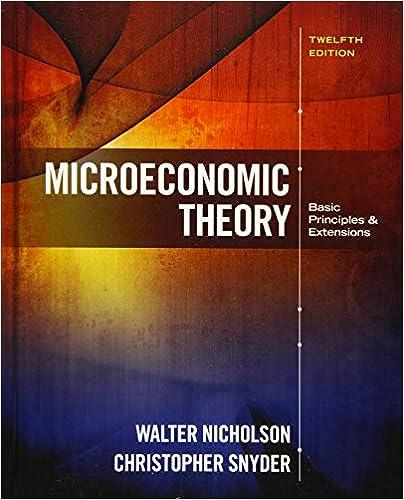More on the comparative statics of supply and demand The supply and demand model presented earlier in
Question:
More on the comparative statics of supply and demand The supply and demand model presented earlier in this chapter can be used to look at many other comparative statics questions. In this problem you are asked to explore three of them. In all of these, quantity demanded is given by D 1P, α2 and quantity supplied by S 1P, β2.
a. Shifts in supply: In Chapter 12 we analyzed the case of a shift in demand by looking at a comparative statics analysis of how changes in α affect equilibrium price and quantity. For this problem you are to make a similar set of computations for a shift in a parameter of the supply function, β. That is, calculate dP∗/dβ and dQ∗/dβ. Be sure to calculate your results in both derivative and elasticity terms. Also describe with some simple graphs why the results here differ from those shown in the body of Chapter 12.
b. A quantity “wedge”: In our analysis of the imposition of a unit tax we showed how such a tax wedge can affect equilibrium price and quantity. A similar analysis can be done for a quantity “wedge” for which, in equilibrium, the quantity supplied may exceed the quantity demanded.
Such a situation might arise, for example, if some portion of production were lost through spoilage or if some portion of production were demanded by the government as a payment for the right to do business. Formally, let Q be the amount of the good lost. In this case equilibrium requires D 1P2 5 Q and S 1P2 5 Q 1 Q. Use the comparative statics methods developed in this chapter to calculate dP∗/dQ and dQ∗/dQ. [In many cases it might be more reasonable to assume Q 5 δQ (where δ is a small decimal value). Without making any explicit calculations, how do you think this case would differ from the one you explicitly analyzed?]
c. The identification problem: An important issue in the empirical study of competitive markets is to decide whether observed price–quantity data points represent demand curves, supply curves, or some combination of the two. Explain the following conclusions using the comparative statics results we have obtained:
i. If only the demand parameter α takes on changing values, data on changing equilibrium values of price and quantity can be used to estimate the price elasticity of supply.
ii. If only the supply parameter β takes on changing values, data on changing equilibrium values of price and quantity can be used to evaluate the price elasticity of supply (to answer this, you must have done part
(a) of this problem).
iii. If demand and supply curves are both only shifted by the same parameter [i.e., the demand and supply functions are D 1P, α2 and S 1P, α2], neither of the price elasticities can be evaluated.
Step by Step Answer:

Microeconomic Theory Basic Principles And Extensions
ISBN: 9781305505797
12th Edition
Authors: Walter Nicholson, Christopher M. Snyder






